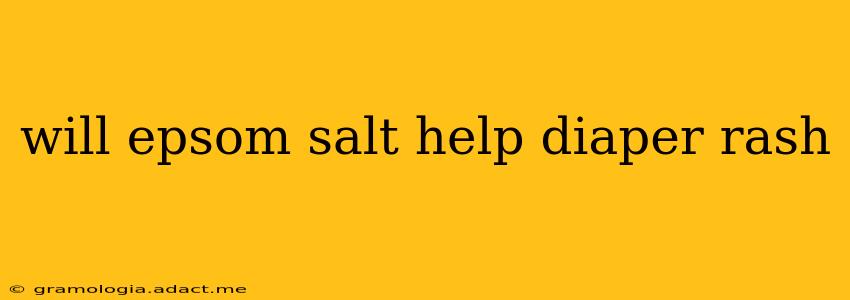Diaper rash is a common ailment among infants, causing discomfort and redness to a baby's delicate bottom. Parents often seek quick and effective solutions, and Epsom salt has emerged as a potential home remedy. But does it actually work? Let's explore the evidence and delve into safer and more effective alternatives.
While Epsom salt (magnesium sulfate) possesses soothing properties and is used for various ailments, its effectiveness in treating diaper rash is questionable and should be approached with caution. There's limited scientific evidence to support its use, and its application can even pose potential risks.
Does Epsom Salt Soothe Diaper Rash?
The primary claim behind using Epsom salt for diaper rash is its purported ability to reduce inflammation and draw out excess moisture. However, this is largely anecdotal. While Epsom salt baths can be relaxing and might temporarily ease some skin irritations, applying it directly to a diaper rash can be problematic. The skin in the diaper area is already irritated and sensitive; introducing a potentially irritating substance like Epsom salt could exacerbate the condition.
What are the Risks of Using Epsom Salt on Diaper Rash?
The potential risks outweigh the benefits. Direct application of Epsom salt can:
- Irritate the skin further: The granular nature of Epsom salt can cause friction and worsen the inflammation.
- Dry out the skin: While some dryness might seem beneficial in reducing moisture, excessive dryness can crack the skin, making it more susceptible to infection.
- Cause burning: The salt can sting broken or sensitive skin, causing further discomfort for the baby.
What are the Better Alternatives for Diaper Rash Treatment?
Fortunately, there are many safer and more effective ways to treat diaper rash:
- Frequent diaper changes: This is crucial to keep the area clean and dry.
- Gentle cleansing: Use lukewarm water to clean the area; avoid harsh soaps and wipes.
- Air drying: Allow the baby's bottom to air out as much as possible.
- Barrier creams: Zinc oxide-based creams create a protective barrier against moisture and irritants. These are generally recommended as a first-line treatment.
- Hydrocortisone cream (low strength): For severe cases, a low-strength hydrocortisone cream can help reduce inflammation, but it's crucial to consult a pediatrician before using it.
Can Epsom Salt Baths Help with General Baby Skin Irritation?
While we advise against applying Epsom salt directly to a diaper rash, an Epsom salt bath might offer some relief for general baby skin irritation (not specifically diaper rash) if diluted properly and under the supervision of a pediatrician. The bath water should be lukewarm, and the concentration of Epsom salt should be very low to avoid irritation. Always test a small area of skin before submerging your baby.
When Should I See a Doctor for Diaper Rash?
Consult a doctor if:
- The rash doesn't improve after a few days of home treatment.
- The rash is severe, with blisters, pus, or bleeding.
- Your baby has a fever.
- The rash spreads beyond the diaper area.
What Causes Diaper Rash?
Several factors can contribute to diaper rash, including:
- Infrequent diaper changes: Allowing urine and stool to remain in contact with the skin for prolonged periods.
- Friction: Chafing from the diaper itself.
- Irritants: Harsh soaps, detergents, or scented wipes.
- Infections: Yeast or bacterial infections can worsen a diaper rash.
- Allergies: Sensitivity to certain diaper materials.
Disclaimer: This information is for educational purposes only and should not be considered medical advice. Always consult a pediatrician or other qualified healthcare professional for any health concerns, especially regarding your baby's health. They can provide personalized recommendations based on your baby's specific condition and needs.
